Introduction
Let’s begin with a simple question. I guess most of us have been to city core or we must have imagined at least. Its more or less similar as in the below photograph (Credits : Markhafer, Source: Wikipedia, Frankfurt CBD). Have you ever gave a logical thought on why there are so many tall buildings in the core? Also, why building height decreases as we move from away city core? Lets try and answer this question in the article.

Before moving forward lets have a quick look on the title: “Bid-Rent theory“. Surely it has something to do with bidding and rent, right ? This theory is going to show that there are some bidders who are bidding to get access to the land in exchange of paying rent.
Related: Ricardian Theory of Rent, Theory of Comparative advantage
Background
This theory has been drawn on concept from microeconomics and is based on the work of Alonso (1964) & Muth (1969). This theory focuses on how the land use patterns are determined by the land values. these are further dependent on the transportation costs & accessibility.
Central Business District (CBD)
In order to make it simpler to understand let’s take an example. Transportation costs are low near to the Central Business District (CBD) and higher as we go farther. Firms located near the CBD are willing to pay more for this centrally located parcels of land in order to minimise their transportation costs. Similarly, because added transportation costs at more distant locations will reduce profits, firms/retail will not be willing to pay as much for land at more distant locations. They would also be losing the accessibility to customers as they move farther from the CBD. An illustration on the firm bid rent function has been depicted in Fig 1.
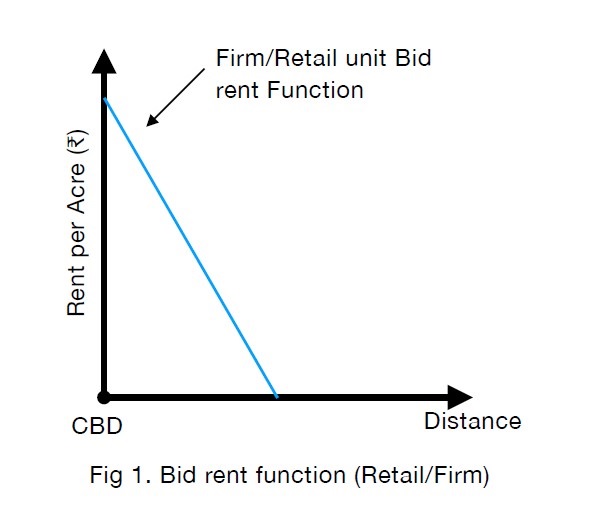
Manufacturing
Now, we are going introduce another economic activity apart from retailing, i.e. manufacturing. For manufacturers, access to markets and labor is important, but less important than for retailers. Also another determinant factor that play a major role for manufacturers is the land holding size as manufacturing units demand more space in contrast to retail units. Under this condition, the slope of the bid rent function for manufacturing will be flatter than the bid rent function for retailers as seen in Fig 2.
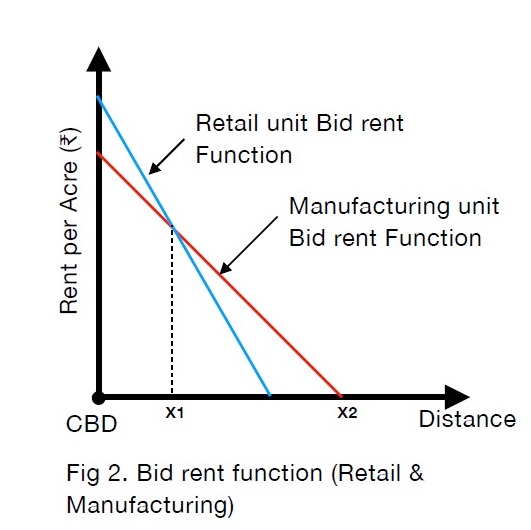
In Fig 2, the intersection of the two bid rent functions, point X1 defines the point at which land use changes from retail activities to manufacturing activities. According to this graph, till the point X1, the retail bid rent line is above the bid rent line for manufacturing. Thus, up to the distance X1, retailers would be willing to out-bid manufactures for the use of land. Beyond X2, the bid rent line for manufacturing is above the retail bid rent line, so manufacturers would be willing to out-bid retailers for land from X1 to X2. I hope you are getting the term ‘bid’ in ‘bid rent theory’ as of now. Thus, under these circumstances would eventually lead us to expect to find the retail activities at a distance of X1 from the CBD and manufacturing activities at a distance of X1 to X2.
Related: Perfect Competition, Monopolistic Competition, Examples of Public Private Partnership (PPP) Projects
Residential
Similarly, last but not the least let’s introduce the location of households. The basic concept fo them is as one goes farther out, the land becomes less attractive to the industry because it doesn’t have easy access to the marketplace and transportation. And since houses do not depend on these factors and land is cheaper, they can buy land out there. (Refer Fig. 3).
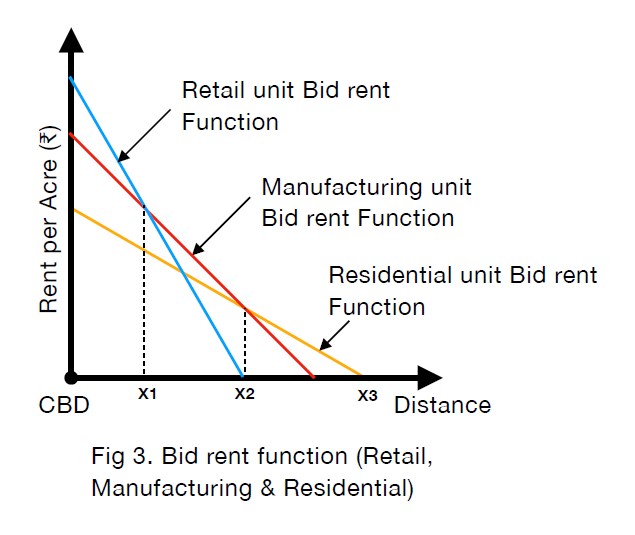
Hence till now we have seen here are the cases based on mainly three different bidders, i.e.
- Retailers
- Manufacturers
- Residents/Households
The Spatial Equilibrium
If we look upon Fig 4, it can clearly be seen the consequences on the land use (if the city is symmetrical which we rarely observe) due to bid-rent theory. It also helps us to understand some important outcomes from the theory of urban land use. Further, this leads to the concept is that of spatial equilibrium. It is a condition in which there is stability in the pattern of land use. Stability of land use occurs when there is no incentive for, say retailers, to out-bid manufacturers for land beyond X1 (at least in this example). Similarly, manufacturers have no incentive to out-bid retailers for land between X1 and the CBD.
The Rent Gradient
Finally, come to the question which has been asked in the the Introduction part. ‘Why there are so many tall buildings in the core? And why building height decreases as we move from away city core?’
Tracing only the upper-most portions of each bid rent function (Refer Fig 1 to Fig 3) renders the land rent gradient, as illustrated in Fig 5.
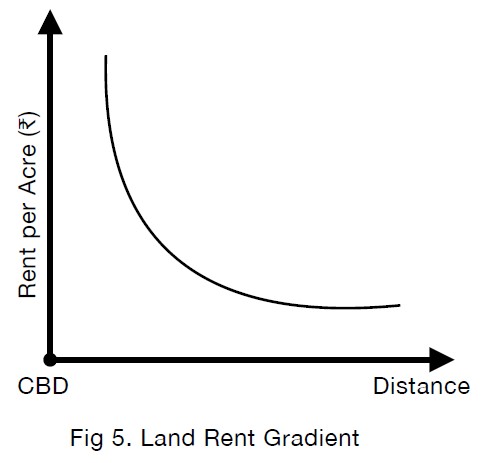
Related: Monopoly, Oligopoly, Gross Domestic Product (GDP), Gross National Product (GNP)
The rent gradient indicates the rate at which the value of urban land declines with distance from the CBD. It is also worthy to note that because land prices increase closer to the CBD, centrally located land will be tend to be used more intensively. The intensity of urban land use is correlated with the height of buildings. Generally taller buildings being located on higher valued land which is why they are found in central business districts. As one moves away from the CBD both the value of land and its intensity of use decline, as do the height of structures.
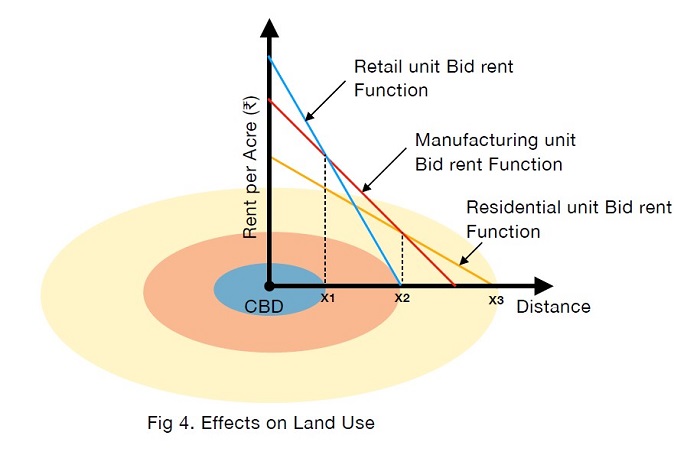
Assumptions & Criticisms
| S.No. | Assumptions made to the model | Criticism of the model |
| 1 | All persons involved in the bidding process have complete information about costs at alternative locations | No consideration of physical Geography |
| 2 | Linear Functioning of Transportation cost to that of Distance | No consideration of Edge cities |
| 3 | All land is privately owned & there is evenly distributed population across the city | What if there is Multi nuclei instead of CBD |
Author:
Shivanshu Shekhar
Member of NOSPlan
School Of Planning and Architecture, Bhopal